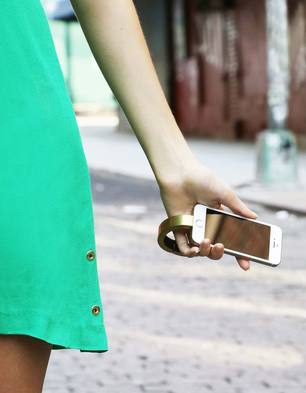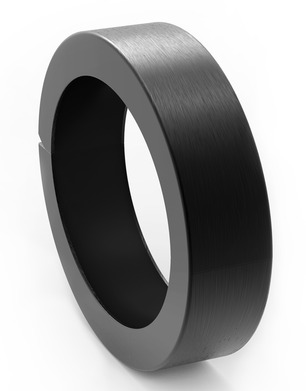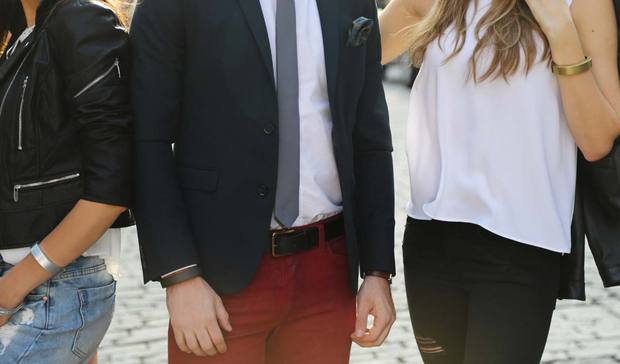Q Designs’ Phone-Charging QBracelet
Never run out of power with this unisex piece of jewelry



A touch of fate brought together friends and business partners Alessandro Libani and James Kernan of Q Designs. Both transfer students to Massachusetts’ Babson College, the duo bonded over their entrepreneurial aspirations and shared love of tech, but it wasn’t until Kernan was on vacation that he came up with an idea for a product they would come to work on together. Kernan’s vision was simple: a bracelet that charges your phone. To achieve this, Kernan tapped his former roommate, whose background in fashion would help them make the idea a reality.
After months of prototyping, they developed the QBracelet, a simple device shaped like a bangle that could restore a little more than 60% of power to a phone. Operated on a hinge mechanism, the gender-neutral bracelet feels like a hybrid between a Nike Fuel Band and a classic bangle. To learn more about the development of the QBracelet, we spoke with Kernan and Libani for a brief explanation of its origins.
What was the impetus for the QBracelet?
James Kernan: Although I’ve had issues with my phone dying ever since I first got my iPhone, I’ve never been a fan of the large and bulky external battery chargers available on the market. It wasn’t until one night’s very unfortunate sequence of events caused by my phone dying, that I decided to do something about it. I was vacationing in Italy and had made dinner plans to meet a friend I hadn’t seen in years. It turned out I had gotten on the wrong bus that had taken me on a completely wrong direction. As I got off the bus in the pouring rain, my phone battery died. I had no way to call my friend and no way to look up directions—it was a complete disaster. On the flight back to California, I started to brainstorm and came up with the concept for the QBracelet.


What was the biggest hurdle in producing these bracelets?
JK: The greatest hurdle was the immense learning curve we had to undergo. Despite the struggles, we were confident in our team’s ability to execute. We had manufacturers tell us a curved battery would not be possible to produce, we had jewelry experts tell us we couldn’t get the coating finishes we wanted due to the materials we were using, and we had engineering and design experts tell us it wasn’t possible to get the size and weight we wanted at the charging capacity we were aiming for. Through hard work and perseverance, we’re proud to say we proved them all wrong. The learning curve was steep, and required us to constantly reiterate our designs, materials and prototyping methods. Looking back, with the expertise we gained in this process, we could probably now build the QBracelet in half the time and cost.
What was the prototyping process like?
JK: The first step was making sure the technology existed and that it would actually be possible to build the QBracelet. We looked at current products on the market, and bought a few to study the internal electronics. Then we built a model of the bracelet to determine how it fit and looked on the wrist. The first model was 3D-printed on a Makerbot printer at The Fab Lab in Berlin.
The next steps were refining the bracelet design while building and sourcing the electronics. By June we had redesigned the bracelet five times, and had numerous prototypes in brass, silver and aluminum in different sizes and weight. In addition, we had received our rare-to-manufacture, custom-curved polymer lithium ion batteries from our supplier in Asia. During this year of prototyping and building the QBracelet, the most valuable resource was listening to what others had to say. People would often meet with us and give loads of advice and constructive feedback that directly benefited the product development.

What was the style inspiration behind the bracelet?
Alessandro Libani: We wanted it to represent one of the many elements that embodies a forward-thinking lifestyle necessary to take fashion/tech to the next level. We were inspired by the 1960s Mod movement. From a fashion and design perspective, Mod was very minimalist, simple and modern looking. And it was one of the first subcultures that created an image that went against the norm.
What are the qualities of good wearable tech?
AL: This is the multi-billion dollar question that some of the leading wearable companies are still trying to figure out. The key is to remember that the word wearable means to wear. Ask yourself, why do we want to wear something? Why do we buy a particular pair of shoes, was it for comfort or for style? Did you put that watch on to tell time or because it makes a statement? We wear athletic clothes to the gym instead of street clothes, but wearable companies expect users to wear the same bracelet to both the gym and a night out on the town. When we envisioned the QBracelet we wanted to create a product that seamlessly combined style and functionality while remaining completely effortless to use.
The QBracelet is now available for pre-order for $79.
Images courtesy of Q Designs












